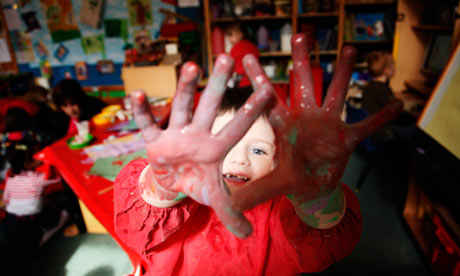 I just got back from a conference on the role of "play" in learning, hosted by the Progressive Education Network. While most of the attendees were K-5 educators, there were a handful of us who wanted to explore this topic in our work with grades 6-12. I'll start by admitting that I am not exactly the most "playful" adult, and so I knew going into this that I might need help bringing play into my classroom.
I just got back from a conference on the role of "play" in learning, hosted by the Progressive Education Network. While most of the attendees were K-5 educators, there were a handful of us who wanted to explore this topic in our work with grades 6-12. I'll start by admitting that I am not exactly the most "playful" adult, and so I knew going into this that I might need help bringing play into my classroom.Beyond the minor tips and tricks that I acquired from attending, the real take-away message for me was the basic premise of the conference itself: play produces meaningful learning. The things we do when we "play" teach us a lot about life. Playing any game begins with a shared premise and mutually accepted "ground rules," which make it possible for us to feel safe, jump in, take risks, and commit to a common goal. Through simple games like four-square, children learn the roles of leaders and followers, participants and spectators. They learn values like fairness, teamwork, trust, humility.
One of the keynote speakers at the conference was Dr. Jill Steinberg, professor in the UW-Madison Department of Human Development and Family Studies. She talked a lot about the research that's been done on the cognitive and social-emotional affects of play. She said that "real" play has a lot of qualities that make it developmentally powerful. First, it actively engages the executive functions of the brain, such as abstract thought, planning, and rule acquisition. Second, it is safely chaotic, which increases children's tolerance for unpredictability in later life experiences. Third, it is voluntary and self-governed, which leads to a greater sense of self-efficacy.
I came away with a number of burning questions:
- How can I create a classroom environment at the high school level that implicitly and explicitly promotes play?
- How can I do a better job of communicating the value of play to my high school peers and superiors?
- How can this idea fit into a school culture where curriculum is pre-ordained and relatively static? How can I "make room" for it in the lesson plans?
I also came away with a number of resources I need to explore to understand some of this further. I'll list some of them here.
Brown, Stuart. Play: How it Shapes the Brain, Opens the Imagination, and Invigorates the Soul. New York: Penguin, 2009.
Elkind, David. The Power of Play: How Spontaneous, Imaginative Activities Lead to Happier, Healthier Children. Cambridge: Da Capo Press, 2007.
Leave No Child Inside: http://www.kidsoutside.info
Meier, Deborah, Brenda S. Engel, and Beth Taylor. Playing for Keeps: Life and Learning on a Public School Playground. New York: Teachers College Press, 2010.
National Institute for Play: http://www.nifplay.org
Singer, Dorothy. Play = Learning: How Play Motivates and Enhances Children's Cognitive and Social-Emotional Growth. New York: Oxford University Press, 2006.

